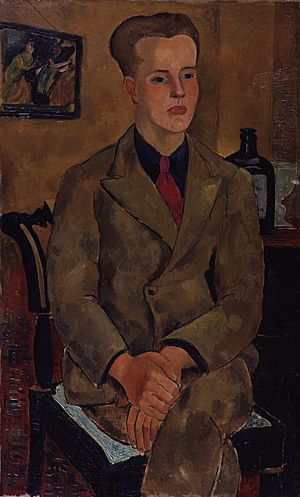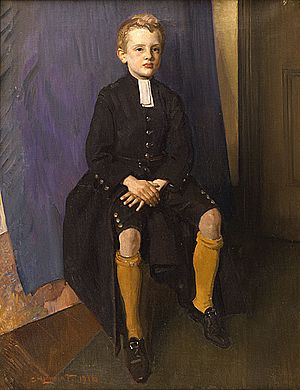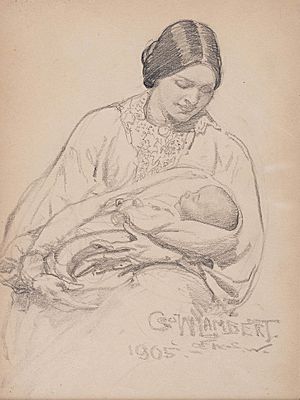Constant Lambert facts for kids
Quick facts for kids
Constant Lambert
|
|
|---|---|

Portrait by Christopher Wood (1926)
|
|
| Born |
Leonard Constant Lambert
23 August 1905 Fulham, London, England
|
| Died | 21 August 1951 (aged 45) London, England
|
| Education | Royal College of Music Christ's Hospital |
| Known for | Composer conductor author |
|
Notable work
|
The Rio Grande Summer's Last Will and Testament Music Ho! |
Leonard Constant Lambert (born August 23, 1905 – died August 21, 1951) was a talented British composer, conductor, and writer. He was a very important person in making English ballet famous around the world. He helped start and lead The Royal Ballet, working with Ninette de Valois and Frederick Ashton.
Even though he spent a lot of time conducting ballets, he still created many musical pieces. His most famous work, The Rio Grande, became very popular in the 1920s and is still performed today. It's a piece for a choir, orchestra, and a piano player. He also wrote a Piano Concerto influenced by jazz (1931) and major ballet music like Horoscope (1937). Some people think his large choral work Summer's Last Will and Testament (1936) is his best work.
Constant Lambert was interested in many things beyond music. His book Music Ho! (1934) shows how he saw music connected to other arts. Famous friends like John Maynard Keynes and Sitwells admired him greatly. Many people thought he was one of the most brilliant and entertaining people in the music world.
Contents
Constant Lambert's Early Life and Music
Constant Lambert was the son of Australian painter George Washington Lambert. His older brother was Maurice Lambert. Constant went to school at Christ's Hospital in West Sussex. From a young age, he showed amazing musical talent. He wrote his first orchestral piece when he was just 13 years old.
In 1922, Lambert joined the Royal College of Music. There, he learned from famous teachers like Ralph Vaughan Williams and Malcolm Sargent. He studied composition, conducting, and piano. Many of his classmates also became well-known musicians.

When he was 20, in 1925, he got a big opportunity. He was asked to write a ballet called Roméo et Juliette (1926) for Sergei Diaghilev's famous Ballets Russes company. This made him quite well-known. He also gained fame for his next ballet, Pomona (1927). He even narrated and recorded parts of the popular Façade by William Walton and Edith Sitwell.
How Jazz Influenced Constant Lambert
Constant Lambert's most famous piece, The Rio Grande, came out in 1927. This work features a piano, a singer, a choir, and an orchestra. It uses a poem by Sacheverell Sitwell. The piece was a huge success, and Lambert himself conducted two recordings of it.
He was very interested in African-American music, especially jazz. He even said he wished The Rio Grande could have been performed with a black choir. Lambert explored jazz even more in his Piano Sonata (1929) and his Concerto for piano and nine Instruments (1931). In these works, his style became more modern and intense. He blended popular and classical music ideas, using sharp rhythms and harmonies that sometimes sounded very new. For example, the second part of his Piano Sonata has a blues section.
Constant Lambert's Later Career
In 1931, Lambert became the conductor and music director for the Vic-Wells ballet, which later became The Royal Ballet. This job took up a lot of his time, and he composed less. His major choral work, Summer's Last Will and Testament (1935), was a very emotional piece. Some critics thought it was his best work at the time.
During World War II, Lambert's health began to decline. He was not able to join the armed forces. He had a serious illness as a child, which made him afraid of doctors. This meant his diabetes was not diagnosed until very late in his life.
Lambert felt he hadn't achieved enough as a composer. After Summer's Last Will and Testament, he only finished two major works: the ballet scores Horoscope (1938) and Tiresias (1951). He also wrote some smaller pieces, like a piano duet for two pianists. He focused mostly on conducting for the Royal Ballet until he left in 1947. He continued to be a guest conductor until shortly before he passed away in 1951.
Constant Lambert's Wide Interests
Lambert was not just a music expert; he also knew a lot about painting, sculpture, and literature. Unlike many other English composers of his time, he understood how important jazz was. He especially liked the music of Duke Ellington. His book Music Ho! (1934) shows his love for music outside of classical styles. It's a very witty book about music criticism.
Constant Lambert's father was Australian, and Constant always felt a connection to Australia, even though he never visited. When his Piano Concerto (1931) was first performed, he chose an Australian pianist, Arthur Benjamin, to play the solo part. He also worked well with another Australian, Robert Helpmann, a famous dancer. Later, he chose another Australian musician, Gordon Watson, to play the piano in his last ballet, Tiresias.
Constant Lambert's Family Life
Constant Lambert married Florence Kaye on August 5, 1931. Their son, Kit Lambert, later became a manager for the famous rock band The Who. Kit was named after Constant's friend, the painter Christopher "Kit" Wood.
Constant also had a relationship with the ballet dancer Margot Fonteyn. Some of Fonteyn's friends said that Lambert was the great love of her life. His ballet Horoscope (1938), in which Fonteyn was a main dancer, showed some parts of their relationship. After divorcing Florence, Lambert married artist Isabel Delmer in 1947. She designed the sets and costumes for his ballet Tiresias.
Constant Lambert had many close friends, including writer Anthony Powell. Powell even based a character named Hugh Moreland in his book series A Dance to the Music of Time on Constant Lambert.
Major Works by Constant Lambert
Ballets
- Romeo and Juliet (1925)
- Pomona (1927)
- Horoscope (1938)
- Tiresias (1950)
Choral and Vocal Music
- Eight poems of Li Po (1928)
- The Rio Grande (1927)
- Summer's Last Will and Testament (1936)
- Dirge from Cymbeline (1947)
Orchestral Music
- The Bird Actors Overture (1924)
- Music for Orchestra (1927)
- Aubade héroïque (1941)
Chamber Music
- Concerto for piano, 2 trumpets, timpani and strings (1924)
- Concerto for piano and nine instruments (1931)
Instrumental Music
- Elegaic Blues (1927)
- Piano Sonata (1930)
- Elegy, for piano (1938)
- Trois Pièces Nègres pour les Touches Blanches (Three Black Pieces for the White Keys), piano duet (1949)
Film Music
- Merchant Seamen (1941)
- Anna Karenina (1948)
Images for kids
-
Lambert aged about eleven in the uniform of Christ's Hospital, painting by his father George Lambert
See also
 In Spanish: Constant Lambert para niños
In Spanish: Constant Lambert para niños







